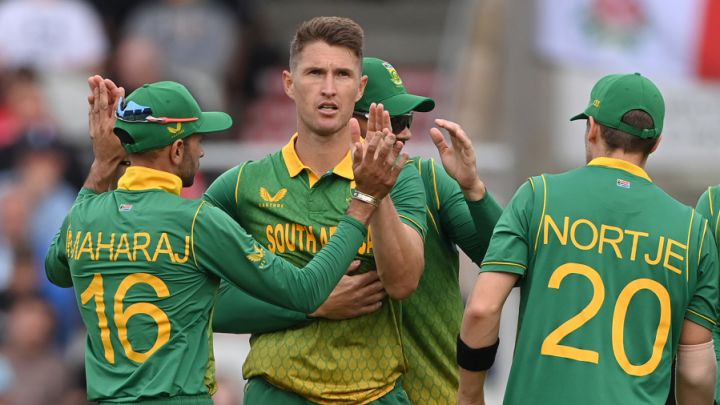Who should open with Quinton de Kock? Dwaine Pretorius, the first-choice allrounder?
Also, Klaasen, Verreynne or neither? Firdose Moonda on the questions facing South Africa in ODIs

A bilateral ODI series that doesn't count for World Cup Super League points in a non-World Cup year could easily leave us wondering what the point of it is, but for South Africa, whose next few ODIs are crucial in their quest for World Cup qualification, these matches have given them some food for thought.
After forfeiting their games in Australia (scheduled for January 2023) to start a T20 franchise league at home, South Africa are likely to find themselves in must-win Super League series soon. They face India in October, England at home next February and Netherlands in two matches that are yet-to-be-rescheduled after being postponed when the Omicron variant of Covid-19 appeared last November. That means this England series was their best opportunity to experiment and get their combinations right for the challenges ahead.
They weren't helped by the absence of regular captain Temba Bavuma, who is out of the tour with an elbow injury, or by two washouts, but there are some takeaways. Here's what they'll be mulling over ahead of big contests later in the season:
Who is de Kock's best opening partner?
Janneman Malan has an ODI average of 55 and could be the fastest South African to 1,000 runs in the format (he has 896 runs from 19 innings and the current quickest, Quinton de Kock, got there in 21 innings) so this could immediately come across as too harsh, but should South Africa scrutinise the pace of their starts?
Malan's strike rate of 85.75 does not feature in the top fifty opening batters since he made his debut in February 2019. In the last year, he is 16th on the list, behind both England's openers, for example, but ahead of David Warner, Aaron Finch and Fakhar Zaman.
With de Kock at the other end, South Africa may not need to consider this too deeply but if they want more explosive openings, there might be an option. It's not Reeza Hendricks who carried drinks in these three matches and strikes at 76.76 or Bavuma, who is used at No. 3 when fit to play. But what about Rilee Rossouw?
With the door re-opened to him in the T20I squad, Kolpak a thing of the past and Rossouw having the highest strike-rate among recognised specialist batters in last season's domestic one-day cup, it's an idea that could pay off as South Africa seek to seal qualification for the 2023 World Cup. Though used mostly at No. 3, Rossouw has opened 21 times in List A cricket and has an average of 46.14, his most profitable batting position. At the least, it's worth a try.
Three seam, two spin for the win
It still seems a little unusual to see a South African attack that is not heavily pace dependent but it's become the norm for this team to field two specialist spinners - Tabraiz Shamsi and Keshav Maharaj - and not just because one of them has had to stand in as captain. The pair have played 16 ODIs together since Maharaj's debut in 2017, and eight under Bavuma's leadership. Together, they maintain an economy rate of under six runs an over (5.25 between them in this series) and take enough wickets (six between them in this series) to also demonstrate a decent ability to threaten.
With three Super League matches in India, a possible qualifying event in Zimbabwe (known for slow, low surfaces) and (they're hoping) a World Cup in India, South Africa are likely to stick to this formula. That leaves the question of how they're going to choose their two best specialist quicks and which allrounder they prefer.
Andile Phehlukwayo's concussion, sustained in the first match, meant that he was unable to stake a claim for the role and Dwaine Pretorius made excellent use of his opportunity, which will make it difficult to displace him. Lungi Ngidi's use of variations have made him a versatile option which could leave Anrich Nortje, Kagiso Rabada and left-armer Marco Jansen (who did not play in this series) competing for one spot.
Klaasen, Verreynne, or someone else in the middle?
There's a bottleneck in South Africa's middle order in terms of who accompanies David Miller at the end of innings. The two closest competitors are Heinrich Klaasen and Kyle Verreynne, with Khaya Zondo also included in the squad on this tour.
Zondo has only played one ODI since being re-selected and that was in the washout against Netherlands, so it's fair to assume he was included as back-up for now. Klaasen, who scored a half-century and a hundred in the warm-ups, was preferred over Verreynne but apart from making the most of his chance to annoy England in the second ODI, he didn't get much opportunity to make a bigger impact.
The actual question should be when did he last make a big impact? Klaasen hasn't crossed fifty in his last 10 ODI innings dating back to the pre-pandemic series against Australia in March 2020. Verreynne, on the other hand, scored two fifties in his last four innings, both in South Africa's previous home summer. Verreynne may consider himself unlucky to have missed out here and even more unlucky if the whole debate becomes moot when Bavuma returns at No. 3 and everyone from Rassie van der Dussen moves down one spot and then there is no room for either him or Klaasen.
Firdose Moonda is ESPNcricinfo's South Africa correspondent
Read in App
Elevate your reading experience on ESPNcricinfo App.